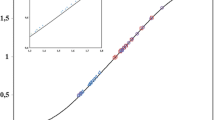Abstract
Processes of complexation in the Fe(0)–Fe(II)–glycine–Na(H)ClO4–H2O system at a temperature of 298.15 K, an ionic strength of solutions of 0.1–1.0 (NaClO4), СFe(II) = 1 × 10−3, and in the pH range of 0.8–8.0 are studied according to the Clark–Nikolsky oxidation potential. Experimental curves are obtained for the dependences of EMF on concentration, рН, pCFe(II), рСHL. Successive approximation of theoretical and experimental oxidative potential functions is used to calculate the constants of complexation. The dependence of the constant of complexation on the ionic strength of the solution is calculated on the basis of the Debye–Hückel theory. It is found that the formation constants of coordination compounds fall as the ionic strength of a solution rises.





Similar content being viewed by others
REFERENCES
M. Beck and I. Nagepal, Chemistry of Complex Equilibria (Akademiai Kiado, Budapest, 1988).
V. F. Gillebrand et al., Inorganic Analysis Practical Guide (Khimiya, Moscow, 1966) [in Russian].
R. Přibil, Komplexony v chemické analyse (Nakl. Českosl. Akad. TED, Praha, 1957) [in Czech].
I. M. Kolthoff, R. Belcher, V. A. Stenger, and G. Matsuyama, Volumetric Analysis (Interscience, New York, 1957), Vol. 3.
G. Charlot, Les méthodes de la chimie analytique: Analyse quantitative minérale (Masson, Paris, 1961).
I. M. Suslennikova and E. K. Kiseleva, Handbook for Preparation of Titrated Solutions (Khimiya, Leningrad, 1968) [in Russian].
P. P. Korostelev, Preparation of Solutions in Analytical Chemistry (Akad. Nauk SSSR, Moscow, 1962), p. 311 [in Russian].
B. P. Nikol’skii et al., Redoxometry (Khimiya, Leningrad, 1975) [in Russian].
Kh. M. Yakubov, Application of Redoxometry to the Study of Complex Formation (Donish, Dushanbe, 1966) [in Russian].
J. A. Davlatshoeva, G. B. Eshova, M. M. Rahimova, et al., Am. J. Chem. 7, 58 (2017).
G. B. Eshova, Dzh. A. Davlatshoeva, M. Rakhimova, L. V. Kvyatkovskaya, and M. O. Guriev, Russ. J. Inorg. Chem. 63, 561 (2018).
G. B. Eshova, Dzh. A. Davlatshoeva, M. Rakhimova, M. O. Guriev, and L. V. Kvyatkovskaya, Russ. J. Inorg. Chem. 63, 772 (2018).
G. B. Eshova, Dzh. A. Davlatshoeva, M. Rakhimova, and L. V. Kvyatkovskaya, Vestn. TNU, No. 1/4 (216), 235 (2016).
Z. N. Yusupov, Tadzh. Rep. Patent No. TJ 295, Byull. Izobret., No. 21 (2000), p. 8.
V. P. Vasil’ev, Thermodynamic Properties of Electrolyte Solutions (Vyssh. Shkola, Moscow, 1982) [in Russian].
Author information
Authors and Affiliations
Corresponding author
Additional information
Translated by S. Lebedev
Rights and permissions
About this article
Cite this article
Rakhimova, M., Eshova, G.B., Davlatshoeva, D.A. et al. Formation of Glycinate Complexes of Iron(II) in Solutions of Different Ionic Strengths. Russ. J. Phys. Chem. 94, 1560–1564 (2020). https://doi.org/10.1134/S0036024420080233
Received:
Revised:
Accepted:
Published:
Issue Date:
DOI: https://doi.org/10.1134/S0036024420080233



